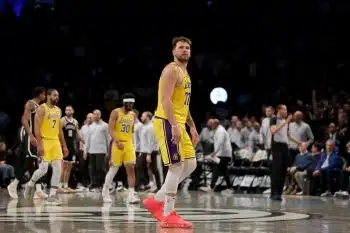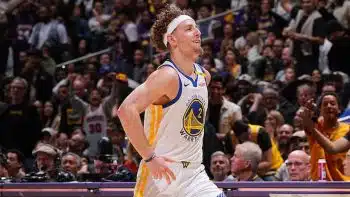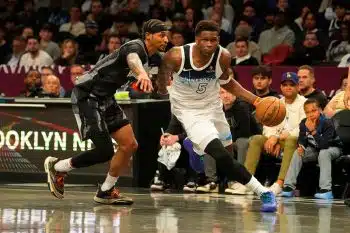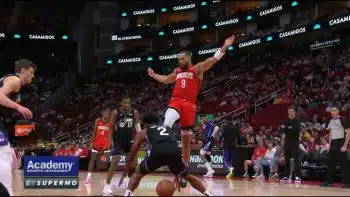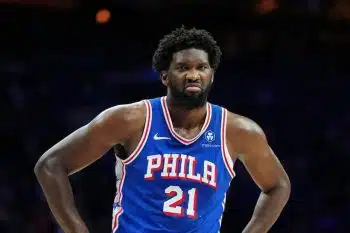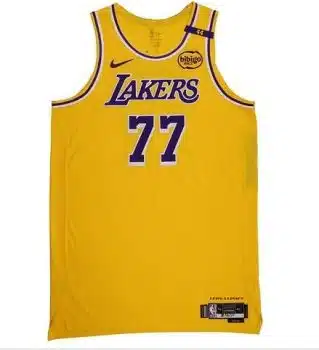NBA
5 Storylines That May Shape The 2024 NBA Finals
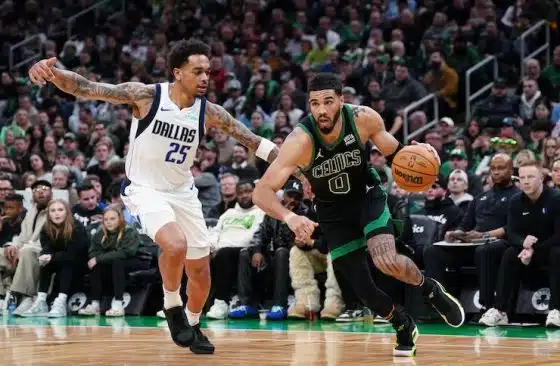
Key Highlights
- The Boston Celtics and Dallas Mavericks faced off once this season following the trade deadline, when Boston won, 138-110
- Dallas’ now-vaunted defense struggled to contain the Celtics, which hit 21 threes and posted a 136.6 offensive rating
- Despite the blowout loss, Luka Doncic was terrific with 37 points, 12 rebounds and 11 assists
- The Mavericks had yet to find their current starting five and opened that game with Josh Green and Dereck Lively starting over Derrick Jones Jr. and Daniel Gafford
For both participants, these 2024 NBA Finals will serve as vastly different experiences than the preceding three rounds. For the Boston Celtics, they’re facing a fully healthy team that has rampaged through the league the past three months, going 35-11 over its prior 46 games with Luka Doncic in the lineup.
Dallas has become a defensive machine and represents the stiffest foe Boston’s league-best offense has faced this postseason. The Celtics haven’t encountered a team the past six weeks with such offensive gusto flanked by range, size and connectivity defensively. Pair that with Doncic’s scheme-proof offensive artistry and the Mavericks’ inclusion here — dashing the hopes of title contender after title contender en route — isn’t hard to grasp.
For the Mavericks, Boston is a juggernaut, touting a tidy 76-20 record through 96 games — winning 64 of 82 during the regular season to nab the NBA’s top record and 12 of 14 during the playoffs for a smooth cruise back to the Finals. The Celtics will sternly challenge Dallas’ revamped defense.
It’s a unit predicated on funneling possessions to shaky shooters and offensive options squaring off with a unit predicated on excising those players from the rotation. The Mavericks call the bluff of five-out offenses and savvy spacing ploys. Boston, meanwhile, doesn’t bluff.
The entirety of its eight-man rotation credibly spaces the floor and most of them can attack closeouts. The wheels of the offense have rarely stopped spinning this season. Dallas will have to solve that riddle, all while navigating a third-ranked defense on the other side.
This is a matchup between the two defining teams of the season: Boston for its eight months of consistent dominance and Dallas for its four-month sprint of marvelous hoops discarding everyone — no matter how presumptively elite — to return to the Finals after a 13-year hiatus.
Let’s dive into some storylines that might shape the series.
Kristaps Porzingis Is A Familiar Face, But A New Challenge For Dallas
Entering this showdown, there will be, understandably, parallels between Porzingis’ game and that of Chet Holmgren‘s, who Dallas saw back in the second round. Despite some lumps offensively, Holmgren was very good in that series. He averaged 15.8 points (59.1 percent true shooting), 6.2 rebounds and 2.3 blocks per game. While Jalen Williams struggled immensely, Holmgren largely held up his end of the bargain as a member of the prominent supporting cast behind Shai Gilgeous-Alexander.
But a few of the holes in his game enabled the Mavericks to stash smaller defenders on him and stress a bit less about his outside shooting than most defenses the Oklahoma City Thunder saw this season. Holmgren is not an adept mismatch scorer yet. According to Synergy, during the regular season, he recorded just 36 post-up possessions and didn’t even eclipse 10 all playoffs (the minimum number for any points per possession leaderboard).
When Dallas took its center off him, he wasn’t a viable option to punish undersized opponents. And although he’s a very good shooter, his slow, one-motion release eases the pressure of an immediate closeout. Because of those limitations, his presence didn’t amplify Oklahoma City’s offense to the same levels as the regular season and invited Dallas to have its centers roam off of highly flawed offensive players, mucking up the Thunder’s drive-and-kick game.
Porzingis is a different flavor of stretch big. He produced 1.30 points per possession on 185 post-up possessions in the regular season (96th percentile) and made a living crushing switches/mismatches. As a spacer, he wields an elevated two-motion release. From the elbows, on the block or beyond the arc, he’ll fire over anyone.
Once a shrewd tactic to disrupt his rhythm, crowding his airspace from below doesn’t usually hinder him anymore. In his lone game against the Mavericks this season, he scored 24 points on 76.1 percent true shooting and showcased this duality.

Guarding Porzingis with a center complicates Dallas’ defensive strategy of anchoring a big to be on 24/7 watch in the paint. He rarely sits in the corners and often resides on the wings, which necessitates odder, longer help responsibilities for opposing bigs and more standard interior rotations for smaller, ill-suited defenders.
If they play drop, Porzingis will flare beyond the arc and hoist open threes. If they switch, he’ll post. If the help comes, he’ll flick the ball to some other qualified shooter and spin Dallas into a frenzied scramble — a place it’s not been much this postseason and one from which Boston excels offensively.

I imagine the Mavericks switch or employ drop early, then adapt if those ideas falter. According to reports, Porzingis is expected to return in Game 1 from a six-week absence due to a calf strain, yet was coy about declaring himself 100 percent.
A compromised Porzingis would probably strain Dallas’ defense considerably less. But if he does provide his traditional imprint, I wouldn’t be surprised if Dallas switches, invites post-ups and brings selective, punctual doubles with size to bother his shooting and passing windows. Regardless, between his own arsenal and the firepower around him, he’s a unique scorer the Mavericks haven’t dealt with this postseason.
Can Boston Slow The Mavericks’ Lob Game?
Through 17 playoff games, Dallas has recorded 54 alley-oops. The second-place Denver Nuggets have nine. Doncic is, of course, a brilliant lob thrower whose radar-level anticipation, deft touch and ingenuity encourage him to toss those suckers at any moment. Kyrie Irving is pretty willing, too.
The bigs, Gafford and Lively, populate to passes like moths to a flame. Every opponent has grappled with this dynamic. Boston is next, and beyond Porzingis, it doesn’t sport much interior size (in the rotation) to potentially curtail this Lobapalooza.
The possible solution is its switch-heavy dynamic. Switch ball-screens. Avoid drop when any sort of aerial threat is diving to the rim, especially given the Celtics’ propensity to play two-on-two in drop and eliminate corner triples. They’ve finished top four in lowest opposing corner three rate both seasons under head coach Joe Mazzulla and are first in the playoffs this year.
Occasionally, the lack of size and schematic tendencies have reared their head. Lively is 10-of-10 from the field against Boston this season.

Switching is palatable because neither Gafford nor Lively are post-up or face-up aficionados; however, it leaves Boston susceptible to second opportunities, with the Mavericks fourth in offensive rebounding rate in the playoffs (29.8 percent).
Josh Green, Derrick Jones Jr., P.J. Washington, Lively, Gafford, Doncic and Irving all rank in the 60th percentile or better for offensive rebounding rate. Gang rebounding will be pivotal. Boston leads the playoffs in lowest opposing offensive rebounding rate.
Including against Dallas this season, Jayson Tatum — an elite defensive rebounder — has a history of capably guarding non-creating centers while Porzingis (or Al Horford) lurks off/defends the least threatening shooter. In an aim to keep the ball in front and reduce Doncic’s paint touches, switching will almost assuredly be the base coverage.
Will that include Horford and Porzingis, though? The former is still pretty good on the perimeter and certainly better than in drop, but the latter is a bit heavy-footed with slow hips and is coming off a lower-body injury.
Dallas has insisted on bringing Boston’s bigs into the action during both regular season games. How will the Celtics handle that? Lots of pre-switching might happen, but the Mavericks will exhaust the well and spam screeners until there’s an empty side with the big unable to stay hidden.
Could a potential remedy be something like this?

The point-of-attack defender fights over the screen, the “big” defender is glued to the roller and the center tags as a low man off of someone like Green, Jones or Washington — though, it’s absolutely plausible they burn this approach by spraying in threes from Doncic’s skip passes.
It’s a deviation from the corner three reluctance, but it’s a gambit Boston found success with last postseason against the Philadelphia 76ers by spotlighting P.J. Tucker’s spacing constraints.
Dallas could counter by keeping Irving in the corner instead, which then might mix around some assignments and make that idea less enticing. The ripple effect from such a decision might open favorable choices for the Celtics as well (strong-side help, peel switch the drives, etc.), and that’s entirely what renders playoff plans so fluid.
No matter what Boston settles on, how it quiets this lob-throwing bonanza, particularly when Porzingis rests, is imperative. Every Mavericks playoffs opponent has seen drastic on-off splits with their starting center. That stems from a confluence of factors: poor backup play; the gulf between Gafford (solid, albeit limited, backup in a starting role) and Lively (good, malleable starter in a reserve gig); the importance of impactful size against the constant lob outlets and Doncic/Irving.
On-off splits for starting centers against Dallas in the playoffs
Ivica Zubac: +8.5
Chet Holmgren: +20.3
Rudy Gobert: +9.9— Jackson Frank (@jackfrank_jjf) June 3, 2024
Horford is a very good backup five, but so is Karl-Anthony Towns and neither is an adept rim protector. The dichotomy — at least in the eyes of Celtics hopefuls — would be their perimeter mobility. For Dallas, Doncic-Horford (or Irving-Horford) dances in spaces is its own point of hypothetical solace. That’s how this sort of projection typically looks: every answer to every problem sprouts new pressure points the opponent is eager to test.
How Does Dallas Use Luka Doncic Offensively?
If Boston elects to defend Doncic with single coverage and lets its center roam off a perimeter player — as it typically did during the regular season — I’d anticipate this being a pretty frequent empty corner post-up series for him. He’s too strong, persistent and wily for any of the Celtics’ most resolute perimeter stoppers (Brown and Holiday will likely get the first cracks).
With the opposing big hovering around the arc, interior help would come from a smaller player less equipped to alter his endeavors. If help does arrive, a lob might be opened up. He already enjoyed some success operating down low against the Celtics this season.
Whether it’s to lather up a stagnant offense or stuck-in-the-mud showings from Doncic, Dallas has embraced the block throughout the playoffs. It doesn’t even have to reach that point either. Gauge how the Celtics are playing him Game 1. If it’s single coverage, spam the back-to-the-basket boogying.

If Doncic continually chisels to one-on-one paint points, perhaps Boston amends its scheme. Maybe, the big shifts to his traditional matchup and readies for help inside. Dallas deviates to ball-screens. Switching is now a thornier move. Drop — or something that inherently invites a numbers disadvantage for the defense (blitz, hedge, show) — becomes the norm. Doncic’s playmaking can breathe, no longer stifled by everyone staying home as his scoring takes initial priority.
It’s easy to conceptualize maintaining your principles and defending him straight up. But it’s much tougher to endure amid a close playoff game when he’s surfing one of his shot-making waves and the objective is about problem-solving rather than cultivating an identity. Boston might have the fortitude to trust itself. Dallas and Doncic will scrutinize that, and a bunch of post-ups might be a reliable way to do so.
Can Dallas Be Itself Defensively?
For the first time all playoffs, Dallas is pitted against a big wing creator with loads of ball-handling depth behind him. Through the first three rounds, every offense had a glaring weak point: shoddy ancillary ball-handling, poor spacing or a mix of both. The Celtics aren’t flawless, but they don’t fit any of those molds and pose such grander issues for the Mavericks than they’ve seen thus far.
Among those grander issues: the existence of Tatum and Jaylen Brown as the Celtics’ top creators, which likely narrows the utility of Washington’s deployment. Part of the Mavericks’ defensive success in the playoffs has been each round allowing for him to leverage his size as an on-ball stopper and off-ball backstop, plugging holes, turning away drives, and spying in help alongside his point-of-attack prowess.
Tatum and Brown muddy that. Washington toggled between both assignments when Dallas and Boston met in early March. He’ll presumably do the same this series.
There isn’t really a place for him to revert back to the off-ball role. He’s the team’s brawniest wing defender and Boston rosters two stars demanding his duties. That multitude hasn’t confronted him or this team yet. How they account for it is crucial to determine if they’re prepared to preserve their defensive tenets.
There were plenty of other problems back in March, but Washington’s inability to give help — either as a low man or from the strong corner — because of his on-ball responsibility contributed to various backline breakdowns.

Every single time, he’s stuck to Tatum on the wing in a place where help rotations would be impossible, risky, or downright foolish. Those well-positioned are caught in conflict. They’re too ineffectual to offer resistance, their man is an outside sniper or a paralyzing intersection of both.
Horford (45 percent), Holiday (60 percent), Derrick White (40 percent), Sam Hauser (48 percent) and Payton Pritchard (43 percent) all knocked down at least 40 percent of their corner threes this season and are the ones Boston usually slots there.
To slide Washington into smaller on-ball duties, Dallas could see if Green and Jones Jr. are up to the task against Tatum and Brown. Yet the offensive concessions are dicey. Boston doesn’t respect either player and routinely helped off of them during the regular season. Could the Washington-Kleber frontcourt — which was so prolific in the regular season (plus-19.5 net rating for Dallas in 451 possessions) — re-emerge?
Whether the Mavericks discover a path to grant Washington more off-ball reps is a vital component of its defensive outlook in this series. His versatility has rightfully been lauded as integral to their defensive turnaround.
Versatility isn’t solely about assuming wide-ranging matchups. It’s also about the manner in which someone impacts possessions. Boston’s roster composition threatens to jeopardize some of Washington’s versatility, and that may loom large for a defense somewhat hinging on it.
Who Does Jrue Holiday Guard?
Jrue Holiday’s defense can be misrepresented. It’s not that he’s really overrated. He’s very, very good. But the strengths and flaws of his defense don’t seem fully fleshed out. He is, essentially, a shutdown corner with ball-hawking tendencies. He enjoys substantial freedom with Boston, and it leads him to gravitate toward the ball, both as a helper and individual stopper.
Overwhelmingly, that benefits the Celtics defense. He loves peel switches to impede drives, excels denying off the ball and is a tremendous point-of-attack pest. But sometimes, these tendencies — notably his decisions while functioning one pass away — backfire. That trend leads me to think he could be best qualified for a roamer role in this series.
Brown, as he primarily did during both regular season matchups, takes Doncic. White — whose discipline, body control and shot contests are marvelous — could supplant Holiday as Irving’s defender. Tatum continues battling Lively (or Gafford or Kleber).
Porzingis, as a repeat of early March, works against Washington; expect to see Washington as a roller/screener more often than normal if this is the case, too. Holiday floats off of Jones to disrupt Doncic and Irving’s pursuits.
His aggressive habits could flourish if enabled to guard Dallas’ most tenuous offensive cogs. Helping off of Irving — who Dallas loves keeping one pass away from Doncic — is far more damaging than helping off Jones, Green, Washington or Dante Exum.

But if Holiday opens on Irving, which feels likely after the regular season, the Mavericks may find some cracks in the defense. They’ve been precise with his off-ball placement all playoffs (all year, really) and will continue to be.
Irving constantly sitting one pass away from Doncic could derail some of the single coverage ideals Boston practices against Doncic (it might be an antiquated ideal if Porzingis and/or Horford are rather ambitious as roamers).
When Irving commandeers offense on the ball during non-Doncic minutes, Holiday should wrangle with him. Otherwise, White seems like the superior option, though it’s possible Irving simply outmuscles him — an advantage he doesn’t lord over Holiday.
Holiday’s penchant for involving himself in the play won’t sink the Celtics’ defense. Yet it does feel like an area to proceed carefully and one that could swing a few possessions each night. Both teams should be alert.
